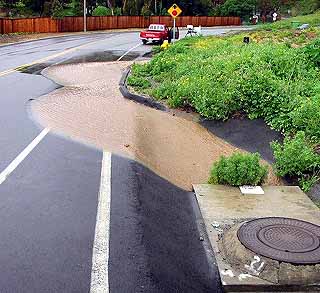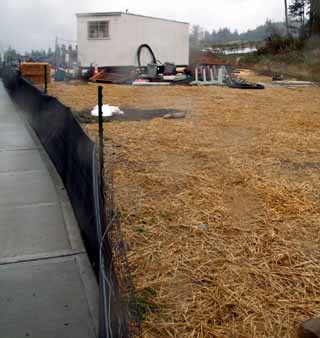
Surveys
DJC.COM
August 3, 2006
Plan ahead for the new stormwater permit
Department of Ecology

Photos courtesy Department of Ecology BAD MANAGEMENT: Sediment is flowing from this construction site into a storm drain. |
It is hard to think about stormwater in July and August, which are typically among the driest months in Washington. But rest assured, come October the rain will be back!
Now is a good time of the year to prepare for the wet weather season. To help with these preparations, developers and contractors are reviewing the Department of Ecology’s updated stormwater management rules for construction sites. Ecology’s new construction stormwater general permit went into effect in December 2005.
Federal regulations now require construction activities that disturb 1 or more acres of soil to be covered under the permit. Previously, a permit was required only if more than 5 acres were disturbed. The permitting process takes a minimum of 38 days to allow for a 30-day public comment period. All application forms and instructions may be found on Ecology’s Web site: http://www.ecy.wa.gov/programs/wq/stormwater/construction/.
Runoff can carry pollutants

GOOD MANAGEMENT: Straw mulch and silt fences are helping contain stormwater at this site. |
Why are people concerned about stormwater runoff from construction sites? The new permit is responsive to recent studies showing that stormwater runoff is a major source of water pollution.
Most pollution from construction sites is sediment from soil erosion. But it is not just dirt that is carried in stormwater runoff. Stormwater can also carry pollutants such as petroleum, metals, pesticides, nutrients and bacteria. Such pollutants harm water quality and aquatic habitat, making streams, lakes, rivers or bays less fishable and swimmable.
Recent research also shows the amount of sediment in the water near construction sites is typically 10 to 20 times greater than before construction began. Over a short period of time, construction sites that do not stabilize exposed soils can contribute more sediment (mud) to streams than was deposited over the previous several decades. These sediments can cause immediate problems for fish by smothering eggs or damaging gills. Sediment and nutrients can also contribute to algae blooms that can consume oxygen from the water column -- suffocating fish and other aquatic life.
Stormwater manuals available
Despite these challenges, developers and contractors don’t need to turn into fish biologists to comply with stormwater permit conditions. Ecology has developed stormwater management manuals for both Eastern and Western Washington to provide the construction industry with the tools to prevent water pollution from stormwater runoff.
The manual provides guidance on how to prepare and implement a stormwater pollution prevention plan, or SWPPP, to protect water quality. Ecology’s Web site also has a simple SWPPP template that takes less time than starting from scratch.
The SWPPP describes site-specific erosion and sediment control best management practices, commonly called BMPs. Smaller sites may only need BMPs like straw mulch to prevent erosion, and silt fences and storm drain inserts to prevent sediment from leaving the site.
Larger, more complex sites may also need designed stormwater structures such as retention ponds and bio-swales. In either case, the key to a successful SWPPP is the right combination of BMPs to prevent rainfall from making stormwater muddy and then allowing the slow release of water from the site to minimize water pollution and downstream erosion.
Since many construction businesses are new to these processes, Ecology’s new permit phases in some of the permit requirements. Sites need to conduct weekly inspections to make sure erosion is being controlled with BMPs. Beginning in October, these inspections will need to be performed by a certified erosion and sediment control lead.
Fortunately, becoming certified does not require getting an engineering degree! It involves a practical, two-day course. Course information can be found at http://www.ecy.wa.gov/programs/wq/stormwater/construction/.
Water sampling required
| Certified training programs |
|
AGC of Washington Education Foundation Phone: (800) 562-2868 University of Washington Engineering Professional Programs (206) 543-5539 ECO 3 (253) 931-8100 Creative Courses LLC (360) 910-4800 Yakima Valley Community College (509) 574-4752 Inland Northwest AGC (509) 535-0391 |
Also beginning in October, sites that disturb 5 acres or more must collect water samples to monitor water clarity, or turbidity, to verify BMPs on site are preventing muddy water from running off-site. Sites smaller than 5 acres don’t have to perform sampling until October 2008. These smaller sites will also have the option of using a simple $35 transparency tube to measure water clarity.
Water sample results need to be submitted to Ecology on a monthly basis. Data will be used by Ecology to prioritize inspections and help us target our technical assistance to where it is needed most.
Developers and contractors can enjoy the blue skies and dry weather this summer, but the planning and training that occurs now will make life easier during the coming rainy season, even though it won’t make the end of summer any easier to accept!
Jeff Killelea, B.S., M.S., is a water quality specialist with the Department of Ecology with a focus on erosion control and stormwater management.
Other Stories:
- Mechanical engineers hop aboard the green bandwagon
- States keep their authority to regulate dams
- UW’s environmental strategy goes from grass roots to daily integration
- New rules for ‘innocent landowners’
- Washington banks on wetland mitigation
- Navigating our water right application process
- Tapping into a sea of power
- Orcas: the next killer environmental issue?
- Minimize data handling to reduce errors
- Solvent spill? Know your cleanup options
- Fish to fly past the ‘Kirkland crawl’
- Getting the creosote out of Puget Sound
- Green Factor would change urban landscape design
- Spokane does brownfields on a grand scale
- Local environment benefits from oil spill
- Conservation program saves money, landfill space
- Education centers show how to tread lightly on the environment
Copyright ©2009 Seattle Daily Journal and DJC.COM.
Comments? Questions? Contact us.